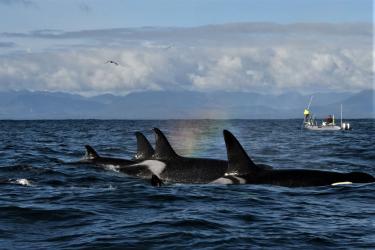Welcome to Sea Turtle Week 2021! This annual campaign celebrates these highly migratory marine reptiles by focusing attention on the threats they face and the conservation efforts to protect them.
There are seven species of sea turtles in the world. Six of them live in U.S. waters: green, hawksbill, loggerhead, olive ridley, Kemp’s ridley, and leatherback sea turtles. All of these species are listed and protected under the Endangered Species Act. NOAA Fisheries and the U.S. Fish and Wildlife Service share jurisdiction over them. NOAA leads the conservation and recovery of sea turtles in the marine environment, while the USFWS has the lead for the conservation and recovery of these animals on nesting beaches.
Sea turtles face significant threats to their survival and their habitat.
-
Bycatch and/or entanglement in fishing gear is the greatest threat to sea turtles in the marine environment.
-
Sea turtles are especially vulnerable to vessel strikes because they come to the surface to breathe and bask, congregate off beaches during the nesting season, and forage in shallow areas where they cannot easily escape vessel traffic.
-
Around the world, sea turtle nesting and foraging habitat is being lost and degraded due to coastal development, pollution, and climate change. Habitat preservation is an important aspect of sea turtle recovery.
Healthy Oceans Need Sea Turtles
Sea turtles play a vital role in supporting productive oceans. They help maintain coral reef ecosystems and transport essential nutrients from the oceans to beaches and coastal dunes. Sea turtles are a “keystone species,” which means they are an essential part of their environment and they influence other species around them.
You Can Help Protect Sea Turtles
Through our research and conservation efforts, NOAA Fisheries and our partners are committed to protecting sea turtles in our oceans and on our beaches. But we need your help too. Here’s what you can do to protect sea turtles and their habitats.
-
Become a conscious and responsible seafood consumer by asking where and how your seafood was caught. Choose seafood caught in ways that do not harm or kill turtles. Consult sustainable seafood information networks to learn about how and where your seafood is caught.
-
Be sure to dispose of your trash and old fishing line/nets in the appropriate trash or recycling receptacles to reduce marine debris that may entangle or be accidentally eaten by sea turtles.
-
Remember to go slow while boating and be observant to your surroundings because sea turtles could be below the water surface.
-
Help keep nesting beaches safe and dark. Knock down sandcastles and fill in large holes when you’re done at the beach for the day. They can be obstacles to sea turtles coming ashore to lay their eggs or hatchlings trying to reach the ocean. Be sure to turn off, shield, or redirect lights visible from the beach so that nesting females and hatchlings are not disoriented by the lights.
-
Contact your local sea turtle stranding network if you see a sick, injured, or dead sea turtle.



